Articles
- Page Path
- HOME > J Korean Acad Nurs > Volume 41(6); 2011 > Article
-
Original Article
- Adaptation of Evidence-based Surgical Wound Care Algorithm
- Jung Yeon Han, Smi Choi-Kwon
-
Journal of Korean Academy of Nursing 2011;41(6):768-779.
DOI: https://doi.org/10.4040/jkan.2011.41.6.768
Published online: December 31, 2011
1Research Assistant, Department of Biobehavioral Nursing Science, Seoul National University, Seoul, Korea.
2Professor, College of Nursing, Research Institute of Nursing Science, Seoul National University, Seoul, Korea.
- Address reprint requests to: Choi-Kwon, Smi. College of Nursing, Seoul National University, 28 Yengeon-dong, Jongro-gu, Seoul 110-744, Korea. Tel: +82-2-740-8830, Fax: +82-2-745-8017, smi@snu.ac.kr
© 2011 Korean Society of Nursing Science
- 824 Views
- 8 Download
- 8 Crossref
Abstract
-
Purpose
- This study was designed to adapt a surgical wound care algorithm that is used to provide evidence-based surgical wound care in a critical care unit.
-
Methods
- This study used, the 'ADAPTE process', an international clinical practice guideline development method. The -'Bonnie Sue wound care algorithm' - was used as a draft for the new algorithm. A content validity index (CVI) targeting 135 critical care nurses was conducted. A 5-point Likert scale was applied to the CVI test using a statistical criterion of .75.
-
Results
- A surgical wound care algorithm comprised 9 components: wound assessment, infection control, necrotic tissue management, wound classification by exudates and depths, dressing selection, consideration of systemic factors, wound expected outcome, reevaluate non-healing wounds, and special treatment for non-healing wounds. All of the CVI tests were ≥.75. Compared to existing wound care guidelines, the new wound care algorithm provides precise wound assessment, reliabilities of wound care, expands applicability of wound care to critically ill patients, and provides evidence and strength of recommendations.
-
Conclusion
- The new surgical wound care algorithm will contribute to the advancement of evidence-based nursing care, and its use is expected as a nursing intervention in critical care.
INTRODUCTION
METHODS
1) Planning: Preparation
Step 1: Define the clinical questions (scope and purpose)
Step 2: Search for guidelines and other relevant documents
Step 3: Screen retrieved guidelines
Step 4: Selection of guidelines and recommendations to create an adapted guidelines
Step 5: Preparation of the adapted guideline draft
Step 6: External review for the guideline target audience
Step 7: Adoption, dissemination and implementation
1) The instruments used for the adaptation process
(1) AGREE Instrument
(2) ADAPTE toolkits
2) Instruments used in the surgical wound care algorithm
(1) Bates-Jensen Wound Assessment Tool (BWAT), 2010 version
(2) Mini-Nutritional Assessment-Short Form (MNA-SF), 2006 version
3) Data collection, data analysis
RESULTS
DISCUSSION
CONCLUSIONS
This article is based on a part of the first author's master's thesis from Seoul National University.
- 1. Manual for guideline adaptation, version 1.0. ADAPTE collaboration. 2007;March 10, 2010. from http://www.adapte.org/www/upload/actualite/pdf/Manual%20&%20Toolkit.pdf.
- 2. Appraisal of Guidelines Research and Evaluation [AGREE] collaboration. Development and validation of an international appraisal instrument for assessing the quality of clinical practice guidelines: The AGREE project. Quality & Safety in Health Care. 2003;12(1):18–23. doi: 10.1136/qhc.12.1.18.Article
- 3. Bolton L, McNees P, van Rijswijk L, de Leon J, Lyder C, Kobza L, et al. Wound-healing outcomes using standardized assessment and care in clinical practice. Journal of Wound, Ostomy, and Continence Nursing. 2004;31:65–71.Article
- 4. Bowler PG. The 10(5) bacterial growth guideline: Reassessing its clinical relevance in wound healing. Ostomy/Wound Management. 2003;49:44–53.
- 5. Collier M. The principles of optimum wound management. Nursing Standard. 1996;10(43):47–52.Article
- 6. ConvaTec. SOLUTIONS wound care algorithm. 2008;Princeton (NJ), ConvaTec, a Bristol-Myers Squibb Company and National Institutes of Health.
- 7. Courtney M. Evidence for nursing practice. 2005;Marrickvile, Churchill Livingstone.
- 8. GRADE Working Group. Grading quality of evidence and strength of recommendations. BMJ. 2004;328:1490. doi: 10.1136/bmj.328.7454.1490.ArticlePubMedPMC
- 9. Graham ID, Harrison MB. Evaluation and adaptation of clinical practice guidelines. Evidence-Based Nursing. 2005;8:68–72. doi: 10.1136/ebn.8.3.68.ArticlePubMed
- 10. Harris C, Bates-Jensen B, Parslow N, Raizman R, Singh M, Ketchen R. Bates-Jensen wound assessment tool: Pictorial guide validation project. Journal of Wound, Ostomy, and Continence Nursing. 2010;37:253–259. doi: 10.1097/WON.0b013e3181d73aab.
- 11. Janis JE, Kwon RK, Lalonde DH. A practical guide to wound healing. Plastic and Reconstructive Surgery. 2010;125(6):230e–244e. doi: 10.1097/PRS.0b013e3181d9a0d1.ArticlePubMed
- 12. Kim ES. Development and application of blood glucose control protocol in medical ICU patients. 2009;Seoul, Seoul National University. Unpublished doctoral dissertation.
- 13. Lee EO, Im NY, Park HA, Lee IS. Statistical analysis for nursing and medical research. 2009;Seoul, Soomunsa.
- 14. Melnyk BM, Fineout-Overholt E. Evidence-based practice in nursing & healthcare: A guide to best practice. 2005;Philadelphia, Lippincott Williams & Wilkins.
- 15. Mirza SK, Deyo RA, Heagerty PJ, Turner JA, Lee LA, Goodkin R. Towards standardized measurement of adverse events in spine surgery: Conceptual model and pilot evaluation. BMC Musculoskeletal Disorders. 2006;7:53. doi: 10.1186/1471-2474-7-53.PubMedPMC
- 16. Myers BA. Wound management: Principles and practice. 2007;2nd ed. New Jersey, Prentice Hall.
- 17. Patel KL. Impact of tight glucose control on postoperative infection rates and wound healing in cardiac surgery patients. Journal of Wound, Ostomy, and Continence Nursing. 2008;35(4):397–404. doi: 10.1097/01.WON.0000326659.47637.d0.Article
- 18. Petzina R, Hoffmann J, Navasardyan A, Malmsjo M, Stamm C, Unbehaun A, et al. Negative pressure wound therapy for post-sternotomy mediastinitis reduces mortality rate and sternal re-infection rate compared to conventional treatment. European Journal of Cardiothoracic Surgery. 2010;38:110–113. doi: 10.1016/j.ejcts.2010.01.028.ArticlePubMed
- 19. Pillen H, Miller M, Thomas J, Puckridge P, Sandison S, Spark JI. Assessment of wound healing: Validity, reliability and sensitivity of available instruments. Wound Practice and Research. 2010;17(4):208–217.
- 20. Polit DF, Beck CT. The content validity index: Are you sure you know what's being reported? Critique and recommendations. Research in Nursing and Health. 2006;29:489–497. doi: 10.1002/nur.20147.ArticlePubMed
- 21. Ruth AB, Denised PN. Acute and chronic wounds: Nursing management. 2007;3rd ed. St. Louis, Mosby.
- 22. Sheer B, Wong FK. The development of advanced nursing practice globally. Journal of Nursing Scholarship. 2008;40:204–211. doi: 10.1111/j.1547-5069.2008.00242.x.ArticlePubMed
- 23. Stevens J. Multivariate statistics for the social sciences. 1996;3rd ed. NJ, Lawrence Erlbaum.
- 24. Sussman C. Bates Jensen BM, Sussman C. Tools to measure wound healing. In: Wound care. 2007;Baltimore, Lippincott, Williams & Wilkins. 123–169.
- 25. William JE, Emily F, Katie M, Patricio M. Wound healing outcomes: The impact of site of care and patient stratification. Wounds. 2007;19:286–293.PubMed
- 26. Wilson MC, Hayward RS, Tunis SR, Bass EB, Guyatt G. The evidence-based medicine working group. Users' guides to the medical literature. VIII. How to use clinical practice guidelines. B. what are the recommendations and will they help you in caring for your patients? Journal of the American Medical Association. 1995;274:1630–1632.PubMed
REFERENCES
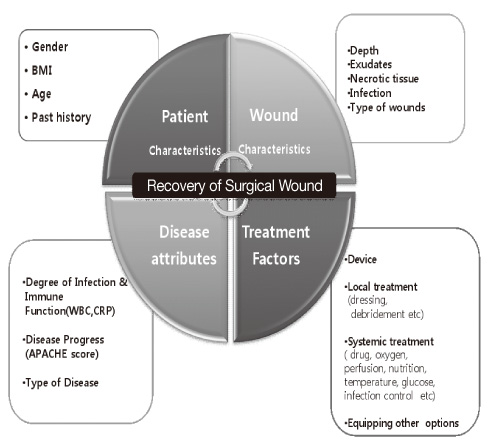
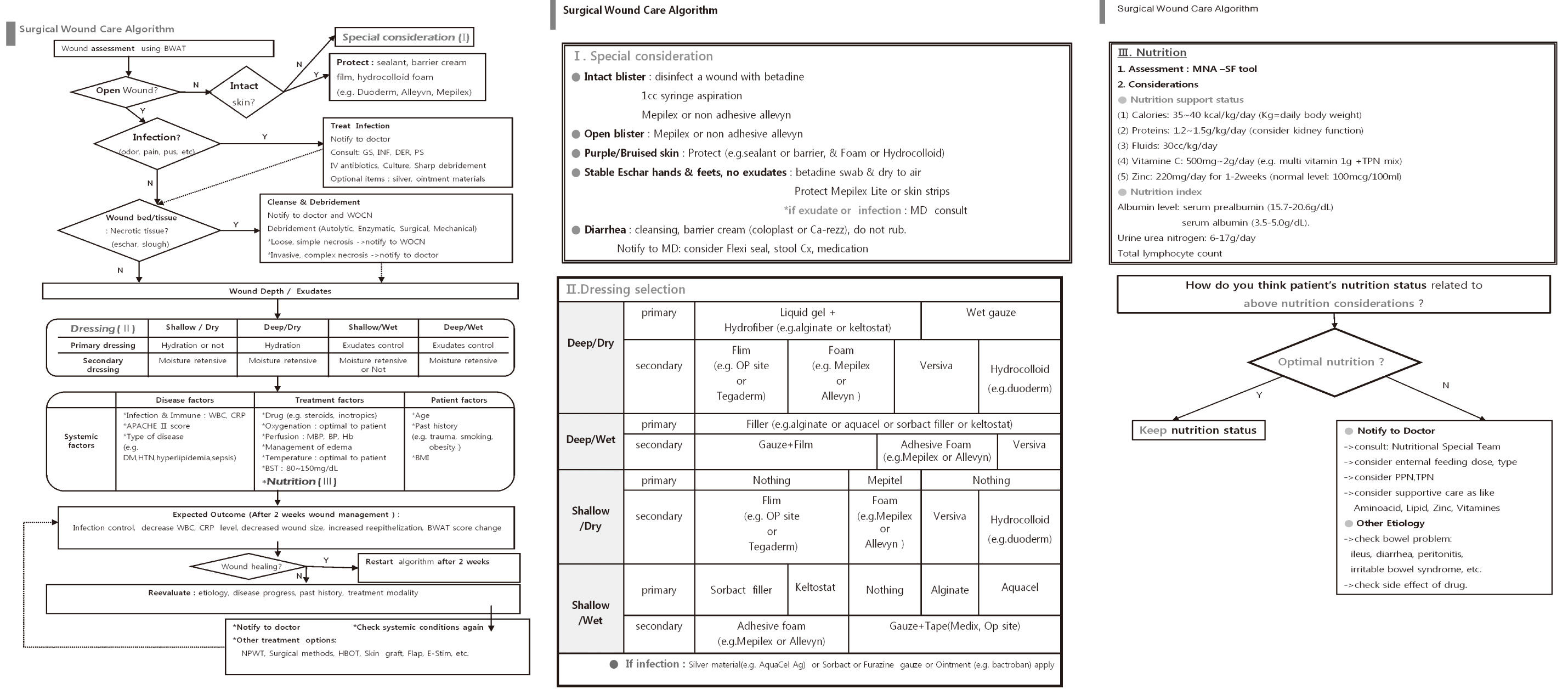
Figure & Data
REFERENCES
Citations

- Xây dựng và chuẩn hóa bộ công cụ đánh giá vết mổ
Thị Thu Hiền Đỗ , Thị Huế Nguyễn , Edwards Helen, FinlaysonKathleen
Tạp chí Y học lâm sàng Bệnh viện Trung Ương Huế.2025;[Epub] CrossRef - Peri-Operative Nurses’ Knowledge on Surgical Site Infection Prevention and Adherence to WHOs Guidelines in Selected Hospitals in Oshimili South Local Government Area, Delta State
Nezianya Lawretta Amanna, C. U. Nwankwo
African Journal of Health, Nursing and Midwifery.2025; 8(1): 140. CrossRef - Bioactive Dressing: A New Algorithm in Wound Healing
Gianmarco Polverino, Francesca Russo, Francesco D’Andrea
Journal of Clinical Medicine.2024; 13(9): 2488. CrossRef - Knowledge, attitude and practices towards surgical wound care and healing among the public in the Jazan Region, Saudi Arabia
Hassan Mashbari, Sulaiman Hamdi, Hussam Darraj, Mohammed Awaf, Shaden Zaalah, Faisal Hakami, Khalid M. Hakami, Essam Alhazmi, Layla Al khairat, Shatha A. Hakami, Amani Aburasain, Ibrahim Ali I. Hakami, Abdulaziz A. Arishi
Medicine.2023; 102(51): e36776. CrossRef - Surgical wound assessment tool: Construct validity and inter‐rater reliability of a tool designed for nurses
Hien Thi Thu Do, Helen Edwards, Kathleen Finlayson
Journal of Clinical Nursing.2023; 32(1-2): 83. CrossRef - Development of a surgical wound assessment tool to measure healing and risk factors for delayed wound healing in Vietnam: a Delphi process
Hien Thi Thu Do, Helen Edwards, Kathleen Finlayson
Journal of Wound Care.2022; 31(5): 446. CrossRef - Exploring guideline adaptation strategy for Turkey: Is “ADAPTE” feasible or does it need adaptation as well?
Duygu Ayhan Baser, Rabia Kahveci, Aylin Baydar Artantas, İlknur Yasar, Hilal Aksoy, Esra Meltem Koc, İsmail Kasim, Ilkka Kunnamo, Adem Özkara
Journal of Evaluation in Clinical Practice.2018; 24(1): 97. CrossRef - Using a Modified ADAPTE Process to Enable Effective Implementation of Electrical Stimulation Therapy for Treating Pressure Ulcers in Persons With Spinal Cord Injury
Deena Lala, Pamela Houghton, Paul Holyoke, Dalton Wolfe
Rehabilitation Process and Outcome.2017;[Epub] CrossRef


Figure 1
Figure 2
List of Clinical Practice Guidelines (CPG)
PICO=Patient, intervention, comparison, outcome.
Level of Evidence, Strength of Recommendations of Surgical Wound Care Algorithm
Balance Sheet of the Surgical Wound Care Algorithm (Bonnie Sue Local Wound Care Algorithm vs. New Surgical Wound Care)
BWAT=Bates-Jensen Wound Assessment Tool.
PICO=Patient, intervention, comparison, outcome.
BWAT=Bates-Jensen Wound Assessment Tool.
 KSNS
KSNS
 E-SUBMISSION
E-SUBMISSION
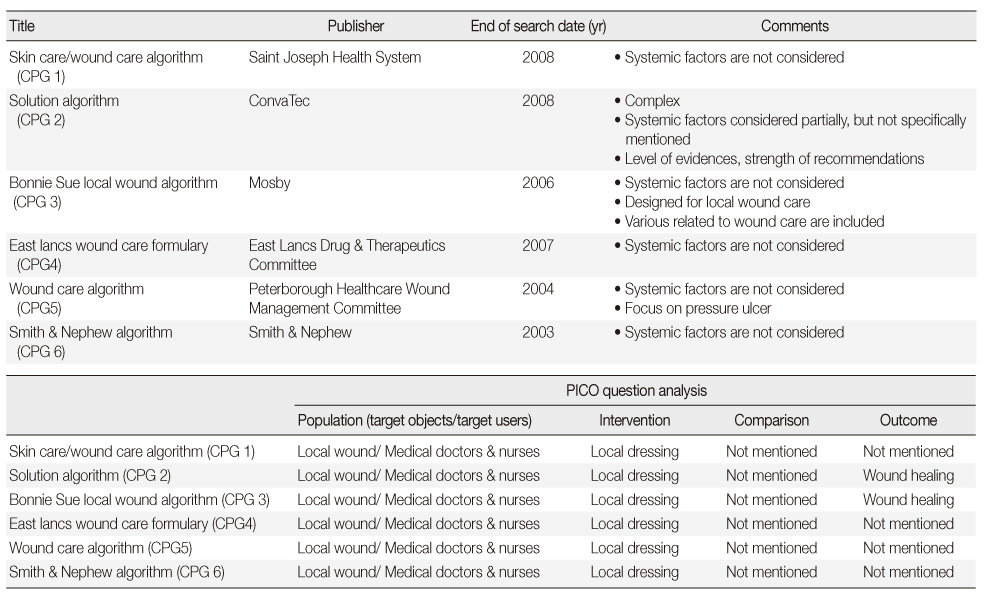
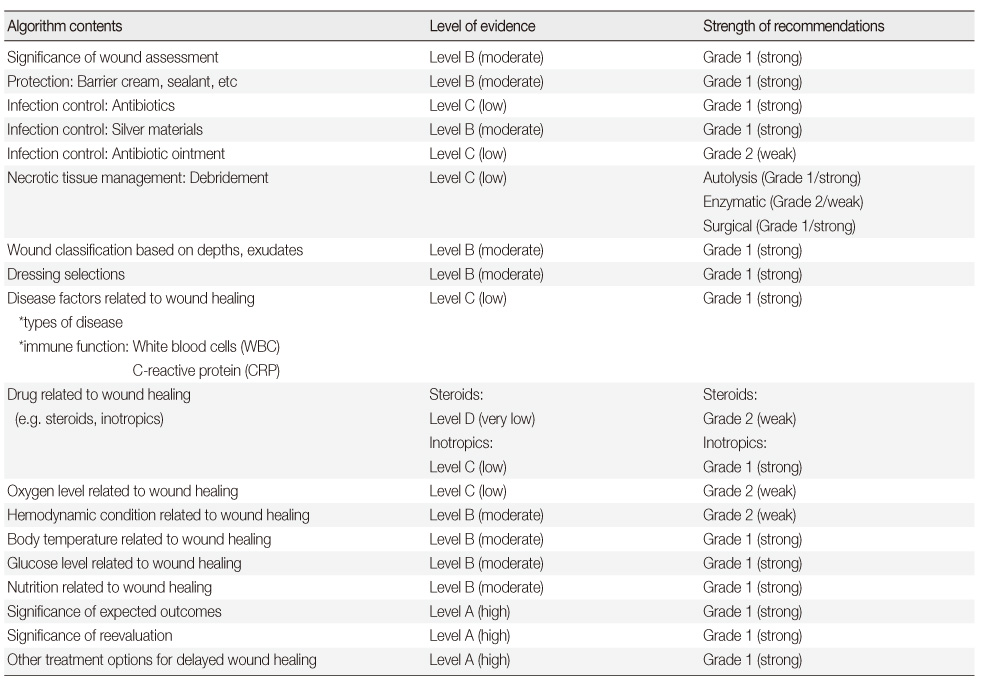
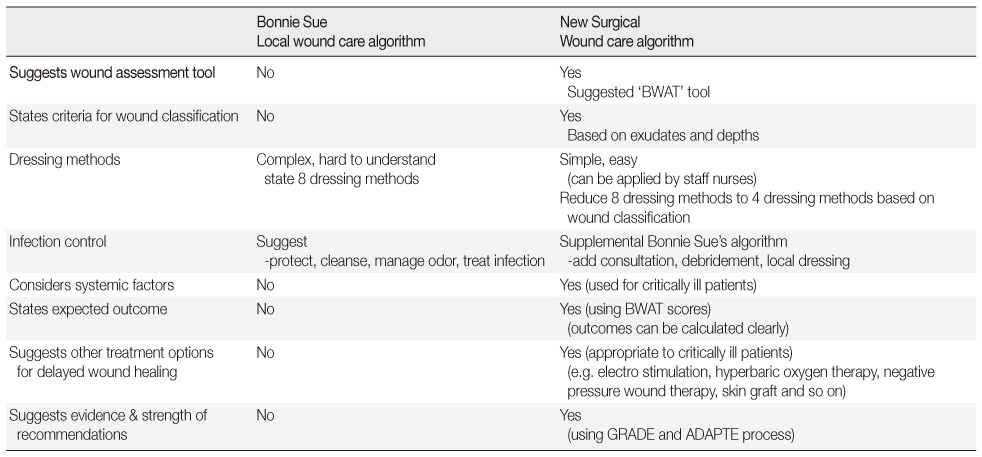
 Cite
Cite

